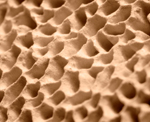Every year my nieces’ elementary school has a winter concert in their gym. Excited kids from all grade levels file into one side of the gym while the parents and friends squeeze into every remaining space. It’s wonderful to see all the kids singing so proudly, but it gets very difficult to hear the music in such a lively space with the parents talking and moving around to get the best camera shot. At Acoustics By Design, we get called in frequently to help design acoustical improvements for large spaces like school gymnasiums, cafeterias, and large classrooms. The big question is always “how much absorption do we need?”
There are two keys to determining the amount of absorption needed in a space: understanding how the space will be used, and identifying the volume of the space. The use of the space helps us determine a target reverberation time, or how long it takes the sound to decay. Once we set a target reverberation time, we can then figure out how much absorption is needed in a space. For example, a classroom and a lecture hall both require intelligible speech communication. A lower reverberation time is desirable to hear and understand the person speaking. The standard classroom has a small volume compared to a 300 person lecture hall. Because of that larger volume, the lecture hall would need more absorption than the classroom to achieve the same low reverberation time. For both spaces, the key is to add the right amount of absorption to achieve the target reverberation time.
But “maximum absorption” to achieve a low reverberation time is not always the goal. In some spaces, a longer reverberation can be desirable, such as in a symphony hall, for example. However, if that same symphony hall will be used for lectures or plays, then the space may need more absorption during those spoken word events. In this scenario (and if the budget allows) we design the space with adjustable acoustical treatment, and reflectors to vary the acoustical response according to the needs of the event.
But the proof is in the pudding. You would not enjoy hearing a lecture inside a racquetball court, nor would you desire to hear a cello concert in an overly absorptive recording booth. There is a science to sound, and we take that very seriously. At Acoustics By Design, we engineer acoustical solutions for all types of spaces. Since we do not sell acoustical products, we design with complete objectivity. Our goal is to help each space achieve the right amount of absorption, and ultimately the desired acoustical environment.
